There is an interesting intersection at which story telling and board games meet. Sometimes they strengthen each other, forming a cohesive experience, sometimes one tries to hide the flaws in the other. I always enjoyed games that have some light story aspect to them to propel the action forward and give me a reason to keep coming back to them over and over again. Things like Oh My Goods!: Longsdale in Revolt, Maracaibo come to mind. I would never had done so many solo plays of the latter if it were not for the – granted pretty thin – story. It’s probably the completionist part of my brain that gets triggered and won’t let loose until I reached the end. On the other end of the spectrum, I’ve never really been interested in campaign games like Gloomhaven or Pandemic Legacy: Season 1, no idea why. Perhaps it seemed too much of a time investment. I remember someone showing me the box of Above and Below once and telling me about the mixture of game and story telling … and that I was quick to suggest a heavy strategy game instead. Aaaah, how times have changed. Fast forward a couple of years, I’m now through multiple campaigns of Sleeping Gods and I blame/thank No Pun Included for that one. Them calling it “one of the best games ever made” was just too much to not at least give it a try and I fell in love with the world, the art and the experience.
When I initially heard about the pre-order for Now or Never, there was something in the way it looked that I thought this one is not for me. Maybe it was the darker color scheme or that the setup looked overwhelming, I cannot remember anymore. But I recently picked up a copy of Near and Far and am having a blast with it. So when I unexpectedly saw a copy of Now or Never showing up on my radar, I got curious and grabbed it! Typically, I like to wait until I had a chance to play something both solo and multiplayer before writing even a first impressions. But there is so much interesting stuff to talk about here, this game just deserves some love and time in the spotlight! So here goes, my impressions after three plays of solo and half way through the story.
This will be spoiler free and only discuss mechanisms and interesting design implications. Still, if you’ve already made a purchase decision, I won’t blame you if you want to do all the discovery yourself and come back here later. Enjoy the game!
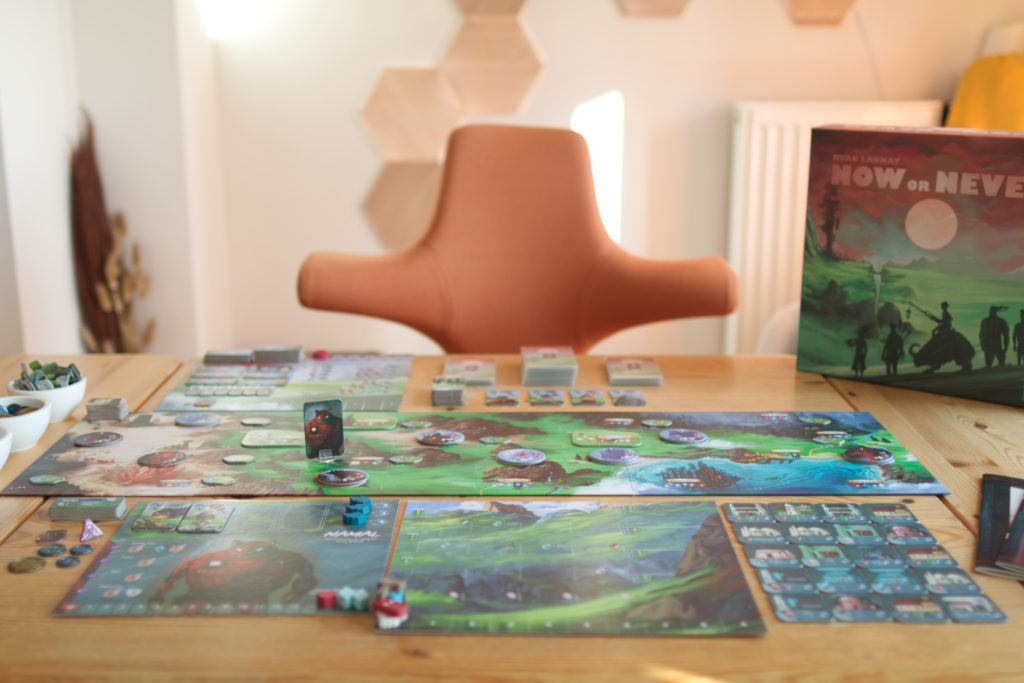
Unboxing
Usually, I like to start with the setup and get right into how it feels to play a game. But with Now or Never, the initial unboxing deserves a few words. First thought when holding the game: man, this box is heavy. I cannot remember a time when I found nine (!) sheets of thick cardboard in a box. Can you? To be honest, this got me a bit worried while I punched everything out. So many different tokens and components are typically not a sign of a well designed game but just bloat. On the other hand, there are games like The Colonists, a game I enjoy very much. So while I kept punching and creating multiple growing piles of token shapes, I was honestly thinking “this will either be awesome or reeeaally bad”.
The second surprise: I initially didn’t find the ziplock bags that are included and thought it maybe being a packaging error. A lot of games have pretty crappy ziplock bags and I typically replace them with bags of various better fitting sizes and of higher quality anyway. But I briefly imagined the family that only rarely plays/buys board games and has to store the hundreds of cardboard tokens just in the box. That’s the stuff nightmares are made off!
Third surprise: there are tokens with images of what looks like tanks? I wouldn’t have expected that one and it might be a turn off for some. Well, it’s not like firing-shots-tanks more drill-equipment-meets-tank-tanks. These are only 9 pieces and they are only used in one chapter of the game but still, it caught me off guard. Perhaps things are more serious in this game? The rest is what you would expect from Ryan Laukat: gorgeous art all around. A nice image of a valley, cheerful people, a robot-cat-warrior, a builder with a floating metal hexagon as a head, …
The standout piece is of course the elongated, double-sided (!) main playing board. Luckily, it’s not as big as I had thought. It is approximately 85cm long but only 24cm high. So it should fit even on smaller tables, unless you have more than two players that is. Anyway, the format makes it look more like a long painting than a normal game board, a fact that is helped by the separation lines between fields being rather subtle. Looks good on the table and I like it, but part of me was initially missing the atlas books I come to know from Sleeping Gods and Now or Never. But those wouldn’t work here for multiple reasons, as we will see later. I can imagine that this type of board might keep some gamers from giving Now or Never a try when seeing it only in passing, as for example on a convention or on BGG screenshots. At first glance, you might say “where is the game” or “how do I move” because the grid is so unobtrusive. All the more reason to talk about it!
Setup
The main board is the central element on the table. It is overlayed by a 10×4 grid (which you have to really zoom in on images to see), some with iconography on them. Small mountain symbols in the corner of a cell indicate difficult travel, monster symbols with a number are the places where the respective monster resides, letters indicate that one of the generic story tokens should be placed and finally three city tiles are randomly placed each on one of the three places marked with a scroll. Once you get used to it, it’s done rather quickly. You will have a standee of your character on the main board and move from cell to cell, much like on a chess board. The gorgeous art underneath “just” gives you a rough idea what type of story encounters might happen there. For travel, it doesn’t matter if the cell is full of water or grass.
Setup time is highly dependent on good organisation. There are 60 small worker tokens which ideally would have had an included cloth bag as their home but sadly none is part of the package. It’s not soooo crucial that you cannot see what you are drawing, so I just keep them in a small bowl and draw from that. Per player, there is an identical set of 20 building tiles, 13 enemies, wooden markers and a four sided die. If you’ve got those in a bag, you can just hand out one bag to each player and they do their own setup. The buildings are shuffled and then laid out in a personal 4×5 grid (more on that later), the enemies are placed in stacks on the main board with a dedicated field for each enemy type (some are only used on the backside or in certain chapters of the story). There is a shared market board that shows gear that is available for purchase, villagers that can be rescued and various combinations of resources that you can trade in for money.
Each player then picks one of the four included characters, gets the respective standee to indicate where in the world that player is, potentially abilities to gain with experience, a board where your village will be built on and the mentioned set of 20 building tiles. This already explains a large portion of why there are so many cardboard tokens in this game. Each player has his one set of city tokens and the number of monsters to fight scales with player count.
Finally you get some coins and fill up some things on your player board, shuffle a couple of cards, and so on, stuff that we’ll skip for now. To sum it up: if you have organised the game a bit, setup time isn’t bad at all. There is a lot to explaining during the first teach but after that, you’re done in a few minutes. Speaking of teach: the rulebook is very good, with reference for each location and gear and I haven’t had a question I haven’t found an answer for. However, particular the setup part is a bit confusing because it mentions names of tokens/icons without showing the symbols to look for. It took me a moment to figure out what the mountain symbol on the grid cells for example was supposed to be (because it’s that small). I would recommend doing the punching and setup before trying to play with a group.
The Turn
A game of Now or Never is played in 6 seasons. When it is your turn, you can either use one of your three hero actions to move on the main game board and interact with the world – or – use a specialist, a person that for the most part allows you to build in your town, heal or get something. Let’s talk about the heros first.
Hero Action
Each player has a unique hero board. On the left, there are 4 red attack slots with abilities printed on them which can be upgraded during the game with experience or by purchasing attack gear. On the right, 3 blue defensive ability/gear slots wait for you to fill them. They are empty in the beginning. In the top right corner are three arrow tokens that are used to track how many hero actions you have already performed this season. Depending on your character, they show different numbers of movement points. At the bottom are your heart and mana track (some characters have more, some less max. mana). The former not only represents health you can loose in combat but also exhaustion you can gain when performing tasks.
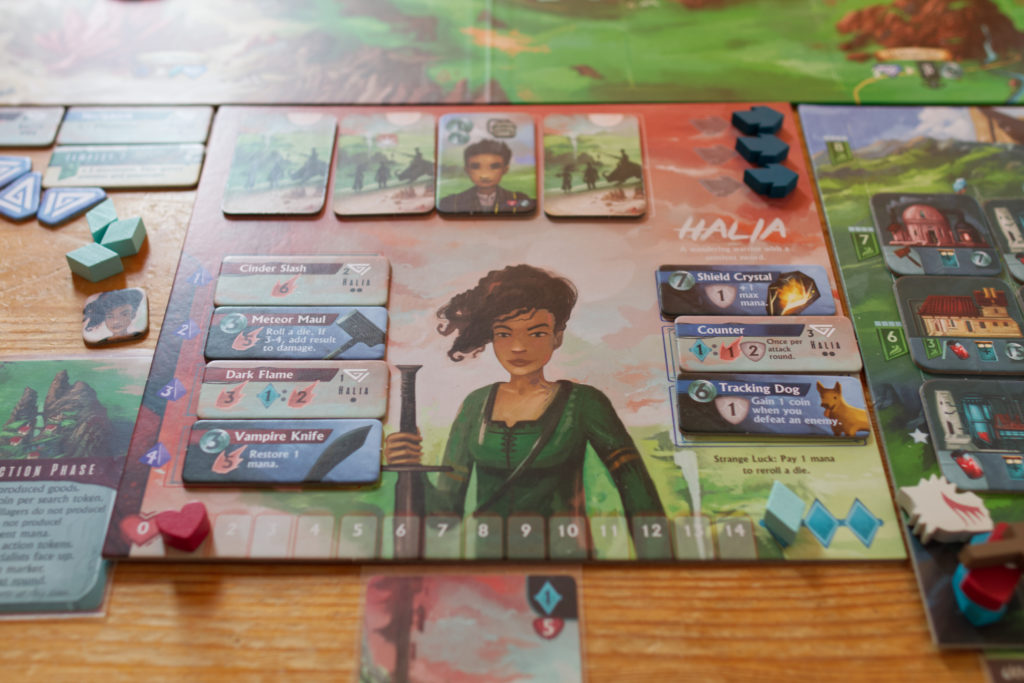
When it’s your turn and you decide to use it for a hero action, you first move to another location on the board, then optionally perform a quest if you have one for that place on your hand and finally either interact with the location as printed on the board, fight with an enemy or perform a search if a search token (I’ll call them story token from here on) is on that grid space. So move, quest, interact. Moving is rather straight forward: check how many movement points the action slot on your player board has, move up to that many spaces and exhaust one heart if you move over/into a space with a mountain or a monster that you want to avoid. If you want to move further, you can, just spent an additional heart per space you want to continue. This is a common theme in Now or Never: often the question is not IF you can achieve something, but how much it will cost/exhaust you. This is actually quite a clever mechanism that prevents one bad die role from messing up your whole season.
Once you are there, check your card hand. You initially get four quests at the beginning of the game and can pick up more later on if you want to. A quest is a card that is associated with a particular place in the world, has a cost to trigger it and gives you either an instant bonus, something you can use once per season or end game points. In addition, you get VP for just having completed (=played) the quest. Quests are not the main source of VP in the game, but they are fun and give you an incentive to move into certain areas of the board you may otherwise not have moved to. Since they are in addition to whatever you want to do on that grid space, they can be a handy bonus source of VP if you time them right.
To finish up on hero actions, let’s briefly talk about the three options: using the printed location typically involves some for of trade. Pay hearts get new villagers, pay experience get money, buy gear, etc. Fighting enemies typically gives you new villagers and/or experience. Combat is quick in this game. You role your D4, check the ability/gear in that attack slot and read how much damage you deal. So rolling a 4 does not mean you deal four damage, it means you activate your fourth slot and depending on your upgrades, that can be either a simple strike or swinging a huge weapon you picked up before. Each enemy has a number of health points. Get them down to zero and you have won. Each enemy also has a number of damage they deal each turn, no die roll needed. Just subtract any defensive gear you have and that’s it. Both damage is considered happening at the same time. If you at any time reach 0 hearts, you’ve lost and the enemy stays on the board even if you would have beaten him in the same round. So combat is part quick dice chucking and part calculated risk on how many combat rounds you can survive with your current health. It’s nothing spectacular, but surprisingly fun and over quickly (which is important in multiplayer)!
The Story Mechanisms
If there is a search token on the grid space, you can instead trigger a story event. The game comes with 6 chapters, each a separate booklet. You start in chapter 1 and next time you play, you pick the next chapter, simple as that. At the beginning of each chapter, some unique tweaks to setup are done and an introduction is read out loud – except for the very first game where each player reads the introduction for his//her character privately. These are not particularly state secrets, but a very nice bit of theming that helps the immersion. The setup tweaks… let’s just say they pick up in pace. At first I was afraid it would be inconsequential changes like in Expedition to Newdale. But don’t worry when chapter 2 feels only like a minor tweak of chapter 1. I’d rather not spoil more.
Story events are rather simple compared to Sleeping Gods and more similar to Near and Far. The player to your left reads the setting, gives you two options and says what skill/combat difficulty the options are. Combat is similar to fighting monsters on the board. The other type of option are “skill checks”. Those are super simple: you roll your D4 and then spent hearts to reach the mentioned threshold. So a Skill 6 check will cost you between 2 and 5 hearts. Similar to Near and Far, you can spent an additional 2 points to get an even bigger reward. That’s it. There is no branching, no multiple approaches, no keywords. What do you want to do: A or B? It’s quite thematic, so if you consider stealing something, you shouldn’t be surprised that that will be more beneficial for your wallet than your reputation.
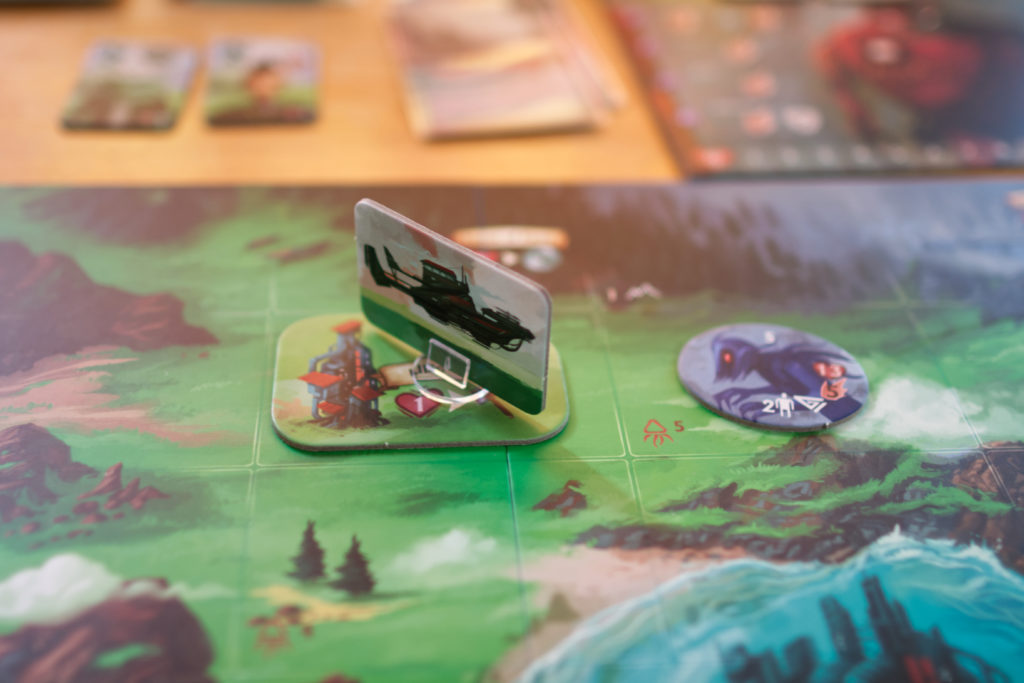
What is unique about Now or Never is how the overall story is told. First, each character has a separate section in each chapter booklet. So if you go to location D with one character and trigger the story, it will be different than when your opponent goes to D with her character. The general event and choices themselves will be the same (as far as I can tell right now), but people treat you differently. Running around with a big sword? People will be more afraid that you are about to rob/kill them. You’re a robot-cat? That will produce a different response, too! I cannot really express how cool this is. It’s “you” interacting with the world. Where in Sleeping Gods the player is like an abstract, viewing over the shoulder of the crew, here it feels more like you are your character. You learn something about you with each story beat.
The second aspect that surprised me is how much the story is not about you, but the world. It’s not an “oh great, the hero has come to save us”. It’s a living, breathing world where people have problems or don’t want to be bothered, ships need unloading or people convincing. I intentionally stop here not to spoil anything. Let’s just say it’s something else than I expected but works great in the overall experience of the game. What is preserved (but to a smaller degrees) from Sleeping Gods is that sense of locality and discovery. The story tokens all are the same, but based on where they lie on that gorgeous map, you can guess a tendency of what will be happening there. If it is close to X, sometimes the story event will be related to X.
End of Game
In the case of Now or Never, explaining the end makes it way easier to explain the rest of the game. So bear with me for a moment.
I said the story is not about you but the world, and that is mimicked in the game mechanics. You don’t win by having fought the most monsters, gathering the most experience or being the most geared up adventurer known to man. No, it’s all about building your town and (re-)populating it. What matters are the buildings you built, the villagers you helped settle into those buildings and – to a small portion – the quests/orders you fulfilled along the way!
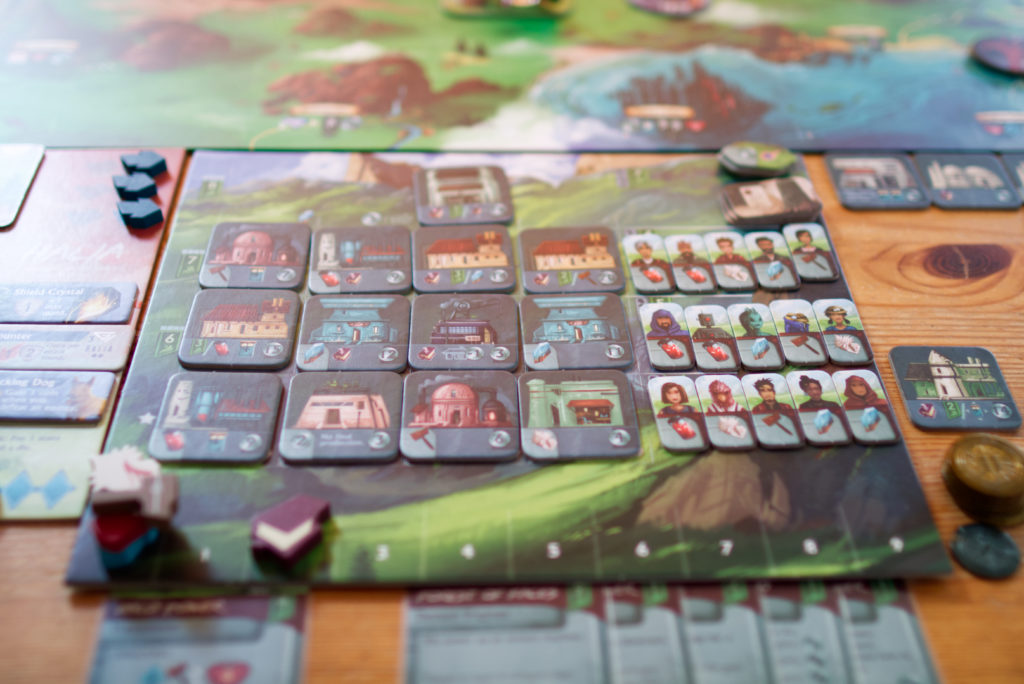
At the end of the last season, before final production happens, you reset all your gathered resources and put your coins back into the supply. Your town then does the final production and you can sell everything created during that production for VPs. You also get bonus points for rows of buildings completed, one of each type of villager settled in a row and quests completed during the game. This has some cool implications on how the game feels: been the greatest hero in the world, fulfilled quests all the time but didn’t build buildings for people to live in? Well, your final production will be appalling. Built a great town with lots of buildings but never bothered to rescue people or otherwise convince them to live in your town? Same result. Never hired specialists to build those buildings? Well, you probably boosted your opponent’s economy by paying taxes to use their specialists. I’m getting ahead of myself. Let’s just say all your heroing on that big, beautiful map are a means to an end: you want to built a great city with a prosperous population in it.
Specialist Action
So how do you build your town? Each players starts off with a grid of 4×5 buildings and two specialists, one for building a building, one for refreshing your heart track. When you chose to use your turn NOT being a hero, you can activate one of your up to four specialists and perform their function such as building, healing, buying gear, etc. You can recruit new specialists from the market, but this is not your party. They live in your town, but they still need to be payed when you want to perform their action. Actually, they are not really working for your, they are hanging around and waiting for hire. So when you perform a specialist action you can either use one of your specialists and exhaust him for this season OR use a specialist of another player and exhaust that one. That player will get a small amount of coins (taxes) as a reconciliation, but that specialist won’t do anything else this round. Either way, regardless of whether it is your specialist or your opponent’s, they expect full pay.
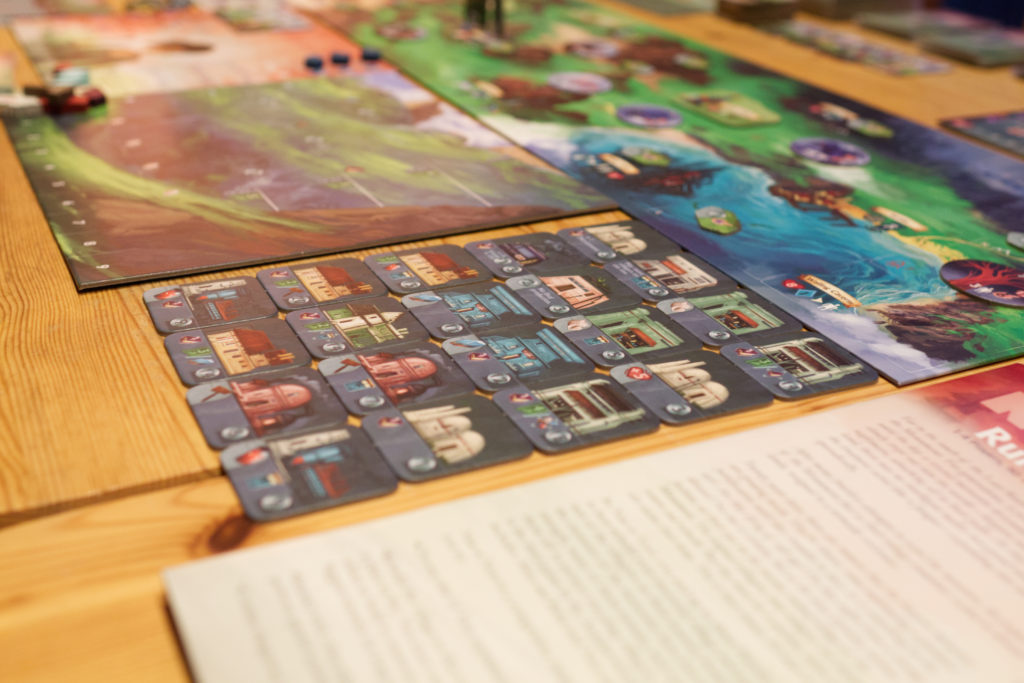
So say you want to build a building. You need 4-5 coins, find a builder-specialist that is available, pay the specialist and then pay for the building (which can get expansive as well). No builder available? No more building for anyone this round. Not enough coins? Hopefully you have some resources which you either gathered from story events or – more likely – during last round’s production phase. The market board shows specific kinds of combinations that you can sell resources for, but you can always sell them individually for a lesser price.
Once you have settled all that, two questions remain: which building to build and where. The latter is rather simple: there are some places on your town board that give you bonuses or increase building costs, but in general you want to fill rows for bonus points. The bigger challenge is what to build. Remember that 4×5 grid of building tokens? Each building is unique and can vary from increasing your production to scoring endgame points or giving you a onetime benefit. For the first building you want to build, you can pick any building on an outer edge of the 4×5 grid. The next building has to be not on the outside but an edge on that gap that you created. So you kind of plot a path through your potential buildings and if not careful might have to build that very expensive one before getting to that crystal production one you really wanted. It’s a simple, easy to grasp mechanic but it is fun!
One other thing that is easily overlooked: you can use one of your specialists to let him/her rest, which gives you either 2 hearts or 1 coin. The only downside is the next player might snatch something important away before it’s your turn again. In general I quite like the specialist mechanism for introducing player interaction. While on the board it is more a “first come first serve” mentality and might tend to a bit of multiplayer solitaire, the specialists force you to pick your actions in the right order. Otherwise you end up with tons of money but not being able to invest it into your production or you build something just to realise that you won’t gather any more villagers this turn. Speaking of the villagers, certain events (mostly fighting monsters) allow you to gather new ones. If you do so, you can pick from an offering on the market board. There are four types of villagers, distinguished by the type of good they produce IF you have settled them into one of your buildings. Nice side note: the rules mention that they do not like moving once settled down, so you cannot move them to another row later on.
I hardly talked about quests, mana, assymetric character abilities and I completely omitted orders which allow you to sell your resources for a premium and 2 extra VP. There are probably more things I forgot or didn’t want to spoil. Anyway, let’s talk about the solo mode before talking about Now or Never as a whole.
Solo
When playing solo, you setup the board for a two player game but only setup the character board for your opponent. The automa does not use a standee, doesn’t have abilities, build a town, etc. At the beginning of each season, you shuffle the automa deck. After your turn, you draw a card and the automa will exhaust a specialist, remove a story token, fight a monster, etc. So basically it is a low-overhead-cleanup-bot type of automa in combination with beat your own score. Taste in automas differs a lot, but for me this is the only weak point of Now or Never. Don’t get me wrong, I’m really happy Ryan Laukat designed one and it is an official part of the game. But there seems so much potential that has been sacrificed for having something that runs quickly. For example, one type of action the automa does is exhaust its left-most un-exhausted specialist. This is rather predictable and easy to counteract. I would have loved it to have more “intend” and for example exhaust the first specialist it can find that would allow it to build (regardless of it being mine or his). Another action lets it draw quest cards and I haven’t been able to figure out yet what consequence that is supposed to have.
I think there is a lot of potential here and I hope someone will try to create a slightly more advanced automa that uses its standee, if not build a city. I’m already collecting ideas for mine The included automa works and it sometimes gets you in a pickle if it snatches away that one crystal-producing villager in the market. But don’t expect too much opposition.
Metal Coins
I would be amiss if I wouldn’t at least briefly mention the optional metal coins. I really like them! The ones from Sleeping Gods are still my favourite but the ones for Now or Never are way nicer than those of Near and Far. They have a nice feel and weight to them. Funny enough, I first thought they would be denominations of 1, 2, 5 and thought it an oversight to not print numbers on them… until I realised there are small dashes in the middle of the coin that show 1, 5 and 10 dashes. Unfortunately, the 1 and 5 are quite similar in colour, especially in bad lighting. But due to the size that shouldn’t be a problem even if your lighting doesn’t suffice to seeing the numbering on them. I’m glad I got them!
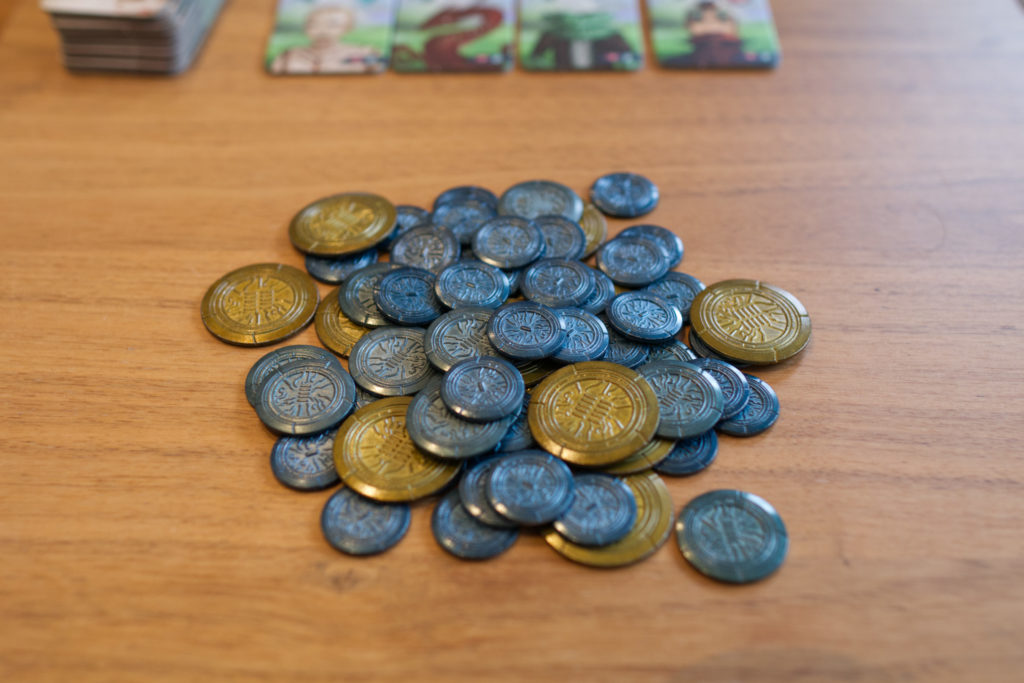
Conclusion
Now or Never is a very ambitious project on multiple levels, and I think it succeeds. From the Red Raven games I have played so far, it is the only one I would be happy playing if there was no story or gorgeous artwork at all. That on it’s own is a big achievement since I’ve gotten pretty picky about which games stay in my collection! It therefore comes as no surprise that the rules actually teach you the “standard game” (without story) first and the story mode is almost presented like a variant. In standard game, the story tokens simply give you a random resource bonus that is printed on their back. That’s it. You have a good, fully functional, challenging economic game. My scores varied between 120 and 180 points which kind of shows how much correct timing and planning is of importance. None of the individual mechanism is particular complex, but as a whole, it works. Even more so because the mechanisms help to support the feel of the story/world. I couldn’t tell if Ryan Laukat first had an idea for the story and tried to find the right mechanisms for it or had thought of the mechanisms and tried to find the right way of story telling that supports them instead of standing in their way.
The pacing is also interesting: by mid game, my character is usually almost maxed out and by the last round, my production is up and running and I’m swimming in money… which then turns all attention on the builder-specialists or opportunities to rescue a last villager. I have a cornucopia of resources but am I able to use them? My character can deal with even the worst monsters, but do I have time to get there? If all of these aspects have been intentional to match the story, that’s an amazing piece of design work.
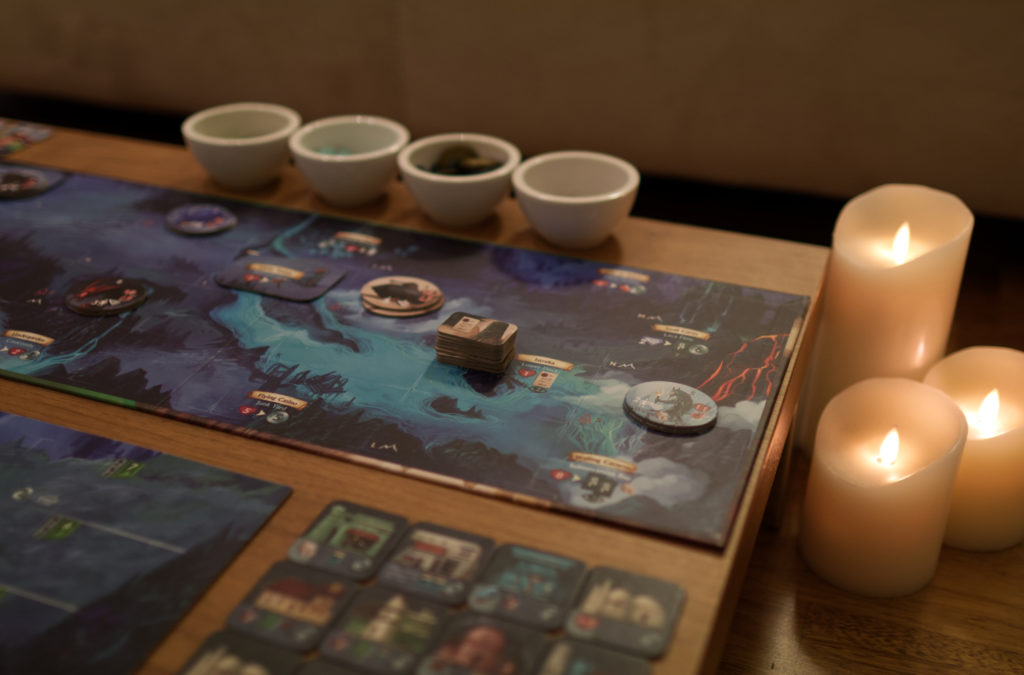
As I wrote in the beginning, I haven’t been able to play it non-solo just yet, but I had moments where the bot exhausted one of my specialists, thus denying me to build any more buildings and seriously hurting my production capabilities. I also once managed to be in a spatial position on the board where I wasn’t able to get any more villagers that round and having been able to build to new buildings didn’t help me much without people living in them. The majority of your production comes from your villagers and only a portion from the buildings themselves. I am wondering though how much this might be multiplayer solitaire connected by shared pool of specialists, what with each player building their completely own city. The times the bot messed up my plans give me hope though! Still, I would have loved it if we somehow would have been re-building one city or there was at least some form of interaction when two players are in the same grid cell. And since we are at minor gripes: I really like Ryan Laukat’s cardboard-resource tokens in other games so I was a bit disappointed to see the resource track with wooden markers. However, I can see that using tokens would have been impractical. The one thing I am worried about is the heart track. Took me only 2-3 turns before I bumped my board and didn’t know how much health it had… in the grand scheme of things, it will not be that important because you are going to refresh your complete health via a specialist quite often anyway.
Going away from the pure mechanics, the weaving of game mechanics and story telling is really interesting in Now or Never. As I said, on the one hand the story beats are customised for your particular, asymmetric character (great thing for replay-ability) but they are typically inconsequential. There is no secret to unlock, no magic artefact to find. However, they are consequential in the sense that you get a feel for the world. It is a place where people live in and the progress of time and other parties have more consequential impact on their lives than you could ever have! A common critique of Near and Far is that not enough story beats are triggered before the game ends, especially in a 2 player game. Here, it seems to be balanced such that a majority of story beats will be hit, the question is just by which player (and thus character, leading to different narration). Besides the potential rewards, doing a search successful gives you the story token which is worth a product of one coin each season. So there is lots of incentive to actually go about and do some adventuring.
Reputation isn’t much use though except VPs. I really liked it that in Near and Far you needed to gain a certain reputation to be able to play cards. Would have been cool if reputation would have been a factor in what options you have in the story moments. The humour of Sleeping Gods is definitely also in here, which I really like, but in general I would say these are more serious times so people are more serious overall. And there are also those emergent game play moments you’ll remember. Without spoiling much, I had the opportunity to gamble at the casino. Of course I rolled and lost, started plotting for a plan B to save my season… only to realise that the special ability of my character was to be able to spent mana to re-roll the die. Guess I was lucky after all!
There are still lots of thoughts I have about Now or Never but this is getting long already. If you’re new to Ryan Laukat’s style of games, this is a great entry if you’re more the euro-gamer type and weren’t interested in the co-op story telling of Sleeping Gods but Near and Far seemed too simple to you. For people coming from Near and Far, I would say expect a much chunkier game (a solo game lasted me 1.5-2.5h with some occasional rules checking!) and a more subtle way of story telling. Your actions (and timing) will have more consequences when it comes to your final score, but less to the story. I’m not far into Near and Far, but so far it’s kind of a “happy place” for me. Everything is fun and cool and it’s mainly the question who wins the race in a game that is always a bit too short for my taste (even with the additional two tents, which you should try if you haven’t!). For people coming from Sleeping Gods, expect way more resource-economics, less persistence of your actions, less branching. When you start a new game/chapter of Now or Never, nothing from your previous game will be left except for your memories of this beautiful world.
P.S.: Shout out to Malorie Laukat! I just watched the Crafting Arium documentation and was astonished by the precision with which she asks just the right questions and how she helped Ryan distill what he wanted to express. Talented composer, too!
Update Jan 26, 2022: Played my first 2-player game of Now or Never and it felt overall quite similar to playing against the bot, which I mean as a compliment to the automa design. The major difference was that getting crystal-producing villagers was way more difficult because we both had to spent experience to cycle the market. Whenever there was one in the market, we rushed to fight a monster or whenever there was none, we delayed a fight and played a game of chicken to see who would do it first and only get shell- and tool-producing workers. The pressure through the specialists is there (also way stronger than against the bot) and being first-player was surprisingly important, especially when it comes to the cheap-to-activate gear-buying specialists. I also had to change the order of my actions 2-3 times because I couldn’t risk my opponent to use up my builder specialist. Overall I would say interaction is mild: enough that you have to be careful what the other person is doing, not enough to ruin your whole turn. However, since we only had a <20 point difference in a 160 point game, those minor snatching away actions do count! Timing combos right to not waste an action is important! Getting orders is also stronger than I thought for a simple reason: your opponent does not know exactly how much money you can produce that round.
Storywise: we collected between 50-60% of the story markers, so less than I thought coming from solo gaming. While fun, it is a risk to do them because you can neither be sure to get the permanent income (some event says discard the token) nor a villager. It seems to be a safer bet to beef up early and fight monsters. Playing with 3 might help because you can be missing out on some story elements that would further motivate what happens in chapter 2, but you get an introduction/summary at the beginning of a chapter either way. Game lengthwise (and table lengthwise) I would assume 2 player is optimal. We played 3 hours plus teach but both are pretty deep thinker-types. My guess is full 4 player should be okay, too, because of how quick turns feel and that an action of an opponent will never completely derail your own plan.
Update Jan 29, 2022: I’ve now played 5 of the 6 chapters and most of what I initially wrote still holds. The core puzzle of how to time your actions and in what order is still fun and satisfying. The three most crucial things are builder-specialists, easier enemies and specific villagers in the market. Often you want to do things in the most efficient order but cannot because the specialist might be exhausted by the time you ideally would use it or that one tool-villager is gone. So you have to plot a bit to figure out what parts of your plan your opponent could mess up and act accordingly. Once your hero is well equipped or your production is up and running, you get 1-2 turns where suddenly everything is possible which feels great after the strenuous first few turns. At least two times it got to ridiculously levels where in the last turn I had so much money that I ended up hiring new builder specialists over and over again just to have additional actions to build.
The part that unfortunately is not working for me personally is the story element. I had hoped for a story that grabs me and makes me say “I can’t wait to continue to play”. Instead I have stopped caring about it. Don’t get me wrong, I would still happily play Now or Never if a friend suggests it. But that is due to the strength of the mechanisms, not the story integration. Doing searches produces unpredictable results and therefore for me degenerates to a backup action I only choose if I can neither fight an enemy nor build something nor progress my character. The story beats themselves are fun to read but they don’t contribute that much to the overall story arc and have virtually no consequences. It feels like being stuck in a certain point in time, you wander around and talk to people, and when the next chapter has started you’ve jumped an arbitrary amount further in time. When I read the introduction of a new chapter, it was often a complete surprise to me as nothing I had heard in the previous chapter led to that result. The setup changes from chapter to chapter are also more a curiosity than that they changed my strategy. Things do get a little bit more difficult due to changes in the enemy setup, but one chapter feels too similar to the other for my taste. There is a progression curve there, but it’s just too flat. There is one chapter where I really felt that things were different and I had to think differently. This was a real highlight for me! I just wished there would have been more situations like that. And that it were my actions that pushed the story and not the story dragging me along. The reputation track (which has no effect during the game except VP) and private missions (which are rare and in-game often don’t provide enough reward to be worth the additional action) feel like the remnants of a much deeper story integration that were cut for some reason, which is a shame. The elephant in the room is of course the total reset of everything you did when you move to the next chapter.
That said, I still enjoyed my 6th game as much as my first game and that is due to the strength of the game itself. I mainly bought Now or Never for the story, so it is a bit of an unexpected “turns out” that I will keep it purely for the mechanisms. Even if you’d strip the story away, you’d still have a fun game – granted with some rough edges. Having the small story beats here and there on top of that puts a nice flavour in a solid core game loop and brings the world to life. One positive aspect: Since the story beats are so inconsequential, I already forgot what I did where in the first chapter and what rewards it produced. So there should be no problem playing each chapter multiple times if I ever want to
Update Feb 7, 2022: If you have read this first impressions and thought “sounds great but the playtime is too long for me”, this might be for you: Ryan has posted some official variants to reduce the playtime and give you a quick start. Reminds me a bit of what Terraforming Mars: Prelude or Underwater Cities: New Discoveries did: Instead of playing the first/second season, you get some predefined villagers, buildings and resources to equate what you might have built in the first/second season. With this new variant of Now or Never, everyone gets the same “boost” so it’s not as elaborate as with the other two games mentioned. But quick thinking by Ryan! Might even be cool to someday have an extended version where there are four options and you roll the one you have to start with. For Underwater Cities, this really “saved” the game for me personally. I don’t think it will have that impact for Now or Never, but then I didn’t mind the original playtime in the first place
